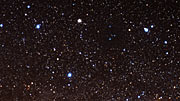Komunikat prasowy
NGC 4945: The Milky Way's not-so-distant Cousin
2 września 2009
ESO has released a striking new image of a nearby galaxy that many astronomers think closely resembles our own Milky Way. Though the galaxy is seen edge-on, observations of NGC 4945 suggest that this hive of stars is a spiral galaxy much like our own, with swirling, luminous arms and a bar-shaped central region. These resemblances aside, NGC 4945 has a brighter centre that likely harbours a supermassive black hole, which is devouring reams of matter and blasting energy out into space.
As NGC 4945 is only about 13 million light-years away in the constellation of Centaurus (the Centaur), a modest telescope is sufficient for skygazers to spot this remarkable galaxy. NGC 4945’s designation comes from its entry number in the New General Catalogue compiled by the Danish–Irish astronomer John Louis Emil Dreyer in the 1880s. James Dunlop, a Scottish astronomer, is credited with originally discovering NGC 4945 in 1826 from Australia.
Today’s new portrait of NGC 4945 comes courtesy of the Wide Field Imager (WFI) instrument at the 2.2-metre MPG/ESO telescope at the La Silla Observatory in Chile. NGC 4945 appears cigar-shaped from our perspective on Earth, but the galaxy is actually a disc many times wider than it is thick, with bands of stars and glowing gas spiralling around its centre. With the use of special optical filters to isolate the colour of light emitted by heated gases such as hydrogen, the image displays sharp contrasts in NGC 4945 that indicate areas of star formation.
Other observations have revealed that NGC 4945 has an active galactic nucleus, meaning its central bulge emits far more energy than calmer galaxies like the Milky Way. Scientists classify NGC 4945 as a Seyfert galaxy after the American astronomer Carl K. Seyfert, who wrote a study in 1943 describing the odd light signatures emanating from some galactic cores. Since then, astronomers have come to suspect that supermassive black holes cause the turmoil in the centre of Seyfert galaxies. Black holes gravitationally draw gas and dust into them, accelerating and heating this attracted matter until it emits high-energy radiation, including X-rays and ultraviolet light. Most large, spiral galaxies, including the Milky Way, host a black hole in their centres, though many of these dark monsters no longer actively “feed” at this stage in galactic development.
Więcej informacji
ESO, the European Southern Observatory, is the foremost intergovernmental astronomy organisation in Europe and the world’s most productive astronomical observatory. It is supported by 14 countries: Austria, Belgium, Czechia, Denmark, France, Finland, Germany, Italy, the Netherlands, Portugal, Spain, Sweden, Switzerland and the United Kingdom. ESO carries out an ambitious programme focused on the design, construction and operation of powerful ground-based observing facilities enabling astronomers to make important scientific discoveries. ESO also plays a leading role in promoting and organising cooperation in astronomical research. ESO operates three unique world-class observing sites in Chile: La Silla, Paranal and Chajnantor. At Paranal, ESO operates the Very Large Telescope, the world’s most advanced visible-light astronomical observatory. ESO is the European partner of a revolutionary astronomical telescope ALMA, the largest astronomical project in existence. ESO is currently planning a 42-metre European Extremely Large optical/near-infrared Telescope, the E-ELT, which will become “the world’s biggest eye on the sky”.
Kontakt
Henri Boffin
ESO
Garching, Germany
Tel.: +49 89 3200 6222
E-mail: hboffin@eso.org
O komunikacie
| Komunikat nr: | eso0931 |
| Legacy ID: | PR 31/09 |
| Nazwa: | NGC 4945 |
| Typ: | Local Universe : Galaxy : Type : Spiral |
| Facility: | MPG/ESO 2.2-metre telescope |
| Instrumenty: | WFI |



